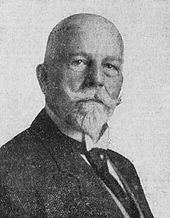Max von Bahrfeldt
Max Ferdinand Bahrfeldt , von Bahrfeldt since 1913 , (born February 6, 1856 in Willmine , † April 11, 1936 in Halle (Saale) ) was a Prussian infantry general and an important numismatist .
Life
Bahrfeldt came from a family in Prenzlau . He embarked on an officer career early on and attended the cadet schools in Wahlstatt and Berlin. Bahrfeldt has been interested in coin studies since his youth. His brother Emil Bahrfeldt was also a well-known numismatist. He specialized in coins from the Roman Republic and coins from Lower Saxony . Bahrfeldt began his numismatic work as early as 1873 as a second lieutenant in the infantry regiment "Bremen" (1st Hanseatic) No. 75 . In 1874 he published his first numismatic essay in Stade . A year later he became co-editor of the Numismatic-Sphragistic Anzeiger. Newspaper for coin, seal and heraldry ” ( Hanover ). From 1876 to 1882 he was a regimental adjutant in Stade. During this time he worked as a secretary in the local history and homeland society and organized its coin collection. He also continues the excavations on the Perlberg urn field . From 1882 to 1885 he attended the Prussian War Academy .
Bahrfeldt married on October 14, 1878 in Gotha Elisabeth (Ella) Mary Charlotte, née Samwer (* October 8, 1859 in Gotha; † October 19, 1954 in Frankfurt am Main), the daughter of the lawyer and constitutional law teacher Karl Friedrich Samwer (1819– 1882), also a numismatist. From the papers he left behind, Bahrfeldt published the “History of the older Roman coinage up to approx. 200 BC” in Vienna in 1883 . Further publications on the coinage between the Elbe and Weser followed. In 1897, following preparatory work by Wilhelm Heinrich Jobelmann and Wilhelm Wittpenning, he published a revised history of the city of Stade . From 1911 he was an honorary doctor of the Philosophical Faculty of the University of Gießen and from 1921 an honorary professor for coinage at the University of Halle .
Military career
From April 3, 1911 to July 3, 1913 he was commander of the 37th Division in Allenstein . On June 16, 1913 Bahrfeldt was as Lieutenant General on the occasion of the 25th jubilee of Kaiser Wilhelm II. Into the hereditary Prussian nobility raised . For his military services he received the star for the Order of the Red Eagle II class with oak leaves and the star for the Order of the Crown, II class. At the beginning of the First World War, from August 2, 1914, Bahrfeldt was in command of the 19th Reserve Division , which advanced in the association of the X Reserve Corps (General Günther von Kirchbach ) via Charleroi through neutral Belgium in northern France. His division fought on August 29, 1914 in the Battle of St. Quentin and at the beginning of September stood before Reims , where he was involved in the Battle of the Marne . In the spring, the 19th Reserve Division was thrown into Champagne and played a significant role in stabilizing the front in the local winter battle .
From June 29, 1915 until his departure in April 1916, he commanded the 10th Reserve Division in the Wöevre plain during the attack on Verdun. Because of the cruelty of his troops in the attack on Charleroi (August 21 and 22, 1914), the Allies declared him a war criminal and put him on a proscription list. In 1925 he was sentenced to death in absentia in a contumacial trial by a Belgian court martial in Mons .
literature
- Gothaisches genealogical pocket book of the noble houses. Part B 1941, Justus Perthes Verlag, Gotha 1941, p. 18.
- Wilhelm Jesse : Bahrfeldt, Max von. In: New German Biography (NDB). Volume 1, Duncker & Humblot, Berlin 1953, ISBN 3-428-00182-6 , p. 543 ( digitized version ).
- Jürgen Bohmbach : Stader Stadtlexikon. Stade 1994.
- Henrik Eberle: The Martin Luther University in the time of National Socialism. Mdv, Halle 2002, ISBN 3-89812-150-X , pp. 364–365.
Web links
- Entry on Max von Bahrfeldt in the Catalogus Professorum Halensis
- Literature list in the online catalog of the Berlin State Library
- Digital copies of the numismatic writings of Max von Bahrfeldt
Individual evidence
- ^ Military weekly paper . No. 81 of June 19, 1913, p. 1863.
- ↑ War Ministry (ed.): Ranking list of the Royal Prussian Army and the XIII. (Royal Württemberg) Army Corps for 1913. ES Mittler & Sohn, Berlin 1913, p. 108.
- ↑ Andreas Toppe (Ed.): Military and international law of war. Legal norms, specialist discourse and war practice in Germany 1899–1940. Oldenbourg Wissenschaftsverlag, Munich 2008, ISBN 978-3-486-58206-2 , p. 136ff.
| personal data | |
|---|---|
| SURNAME | Bahrfeldt, Max von |
| ALTERNATIVE NAMES | Bahrfeldt, Max; Bahrfeldt, Max Ferdinand |
| BRIEF DESCRIPTION | Prussian infantry general and numismatist |
| DATE OF BIRTH | February 6, 1856 |
| PLACE OF BIRTH | Willmine |
| DATE OF DEATH | April 11, 1936 |
| Place of death | Halle (Saale) |
